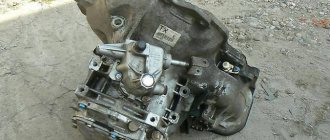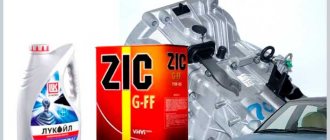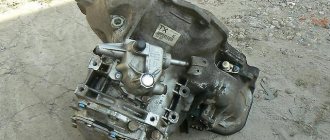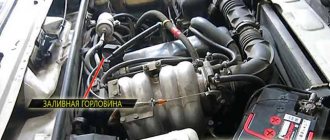The gears of any gearbox are subject to intense wear, so manual transmission lubrication can increase the service life and reduce maintenance costs. Transmission oils are classified by several specifications and do not have the same markings and composition, so the user must have at least minimal information about lubrication of a manual transmission.
Manual transmission oil
Purpose of gearbox lubrication
The gearbox is the largest gearbox in a car transmission. Thanks to a stepwise change in the gear ratio, the driver has the opportunity to combine two ranges - wheel speed in the range of 50 - 1500 min-1 and engine crankshaft speed 800 - 8000 min-1. Depending on the type of transmission, the gears of the gearbox are lubricated in the following ways:
- cylindrical - oil bath with immersion of low-speed wheels to a third of the diameter, high-speed wheels to a depth of h = 5m;
- bevel - crankcase lubrication with the entire lower tooth of the gear immersed in oil;
- planetary - the high-speed stage is immersed in an oil bath to the entire depth of the inner tooth.
Spur gear box
Planetary gearbox
The drain hole must have a diameter greater than 20 mm, and the slope of the crankcase bottom must be within 3 degrees. The filler plug is usually located at the level of the oil bath mirror, which makes it possible to do without a dipstick.
Manual transmission drain hole
Information about what kind of oil to pour into a manual gearbox is relevant when repairing components and assemblies associated with the gearbox (for example, replacing the clutch) when the life of the lubricant itself is exhausted.
Transmission filler hole
The gearbox traditionally belongs to units with high operating loads. In addition, passenger car manufacturers use different gear designs in different car models, so the frequency of oil changes in manual transmissions is required in the manual.
The user should note that changing the oil in a manual transmission has nuances:
- with a minimum maintenance budget (filling with mineral oil), operating costs will increase as the lubricant life will decrease;
- when purchasing expensive synthetics, on the contrary, the initial investment will increase, but the service life of such oil is longer and the replacement frequency is greater than in the previous case;
- Semi-synthetics have a rational ratio of lubricant quality and cost.
Mineral oil
Synthetic oil
Semi-synthetic oil
There are winter, all-season and summer oils that allow you to select a lubricant for different operating conditions.
Thus, oil in a manual transmission solves several problems simultaneously:
- lubrication and reduction of friction of gears;
- heat removal from friction pairs;
- removal of metal filings from the surfaces of wear parts of the gearbox;
- protection of gears and gears from oxidation and corrosion.
The cost of 3 liters of gear lubricant is significantly lower than replacing a manual transmission or breaking a gear while driving.
Comparison table of characteristics
To compare the selected oil models, we will use a comparison table.
| Type | Min. t °С, | Max. t °С, | according to SAE | via API | |
| Luxe 80W-90 GL-5 | mineral | -40 | +150 | 80W90 | GL-5 |
| Castrol Syntrans Transaxle 75W90 | synthetics | -54 | +150 | 75W90 | GL-4+ |
| Lukoil GL-5 75W90 | semi-synthetic | -40 | +190 | 75W90 | GL-5 |
| Total Trans SYN FE 75W90 | semi-synthetic | -51 | +190 | 75W90 | GL-5 |
| Liqui Moly Hypoid-Getriebeoil TDL | semi-synthetic | -40 | +170 | 75W90 | GL-4/5 |
| Total 75W80 BV | mineral | -45 | +200 | 75W80 | GL-4+ |
| Zic GF TOP 75W-90 | synthetics | -45 | +230 | 75W90 | GL-4/5 |
Manual transmission operating modes
Due to operating conditions, the car's gearbox must provide 1 - 2 lower gears, reverse speed and several higher gears. Large ratios (5/1 – 3.5/1) are used in lower gears. At the same time, the transmission of an SUV reaches a power range of 9 units, while in passenger cars it is limited to 6 units. The traction force in lower gears is maximum, but the car cannot reach high speed.
Low gear
The gear ratios of the middle gears are in the range of 2.5/1 – 1.5/1. Engine noise is reduced at the same speeds. These gears are considered “short” and greatly tire the driver, as they require frequent switching in changing driving conditions.
Middle gear
Higher gears reach a gear ratio close to 1/1, that is, the shafts rotate at the same angular speeds. This is convenient on the highway when driving at a constantly high vehicle speed.
Top gear
Classic gearboxes usually use 3 shafts - primary, intermediate and secondary. The gear units have helical gears to reduce noise. In addition to gears, the box contains synchronizers, cams and clutches.
For gearboxes with old-style synchronizers, budget manual gearbox oil marked GL-4 is used. For most modern cars, manufacturers specify hypoid oil GL-5.
Gearbox with synchronizer
Attention: An attempt to improve the quality of the lubricant in the gearbox of a domestic VAZ with high mileage will lead to the exact opposite effect - the operation of the synchronizers will be disrupted, since the films from these transmission lubricants have different properties.
The oil should be changed either at a service station, whose employees do not make such mistakes, or you should adhere to the requirements specified in the machine’s operating manual.
Transmission lubricant is considered a consumable material; after a certain mileage, its components begin to deteriorate, and metal shavings and foreign impurities accumulate inside, and the modifying additives decompose. That is why changing the oil in a manual transmission must be timely and technically competent.
For automatic transmission
In automatic transmissions, the loads are distributed slightly differently compared to previous types of transmissions, so the lubrication for them must be different. In this case, the canister will have the corresponding marking - ATF (the most common for most automatic machines).
In fact, these liquids have similar characteristics as the previous ones - extreme pressure, anti-corrosion, cooling. But for the lubrication of automatic machines, the requirements for viscosity-temperature characteristics are more stringent.
There are different types of automatic transmissions, and for each of them, manufacturers strictly regulate the use of a specific oil. The following modifications are distinguished:
- Gearbox with torque converter. The lubricant in such transmissions additionally plays the role of hydraulic fluid, so the requirements for it are more stringent - especially with regard to its fluidity.
- CVT. There is also a separate oil for these types of transmissions. The canisters of these products will be marked CVT.
- Robot box. It operates on the principle of a mechanical analogue, only in this case the clutch and gear shift are controlled by an electronic control unit.
- Double clutch transmission. Today there are many modifications of such devices. When creating their “unique” transmission, manufacturers impose strict requirements on the use of lubricant. If the car owner ignores these instructions, then in most cases the car will be removed from warranty.
Since oils for such transmissions have an “individual” composition (as manufacturers claim), they cannot be classified according to API or ACEA in order to select an analogue. In this case, it would be better to listen to the manufacturer’s recommendations and buy the one indicated in the technical documentation.
Selecting a lubricant for a manual transmission
According to the international API system, developed by the American Petroleum Institute, manual transmission oil is marked with the letters GL. Of the six existing classes, only GL-3 and GL-4 modifications are used in manual transmissions. However, gearboxes with hypoid gears use GL-5 oil.
| Designation | Compound | Purpose |
| GL-1 | no extreme pressure additives, only base oil | transmissions without synchronizers |
| GL-2 | anti-wear modifiers | not suitable for gearboxes |
| GL-3 | 2.7% anti-wear additives | for MPP with spiral bevel gears |
| GL-4 | 4% extreme pressure modifiers | for manual transmission with synchronizers |
| GL-5 | 6.5 additives, including extreme pressure | for boxes without synchronizers |
| GL-6 | more than 7% sulfurphosphorus-containing additives | only for hypoid gears |
In the domestic GOST standard, transmission oils are designated TM. The marking uses two numbers separated by a hyphen:
- first – viscosity class;
- the second is a group for deciphering operational properties from the table below.
Viscosity class according to GOST
Operating group of oils according to GOST
TM-3 – TM-5 is poured into mechanical boxes for temperature conditions within 150 degrees.
In addition, the gear lubricant has a viscosity classification according to SAE, developed by the American Society of Engineers. There are seven classes in the SAE system:
- four winter ones marked W;
- three summer ones without markings;
- several all-season with double markings.
SAE oil classification
For example, multi-grade gear oil for manual transmissions marked 75W90 simultaneously has the characteristics of a 75W winter gear lubricant and a 90 summer gear lubricant.
Leading gearbox manufacturers General Motors and Ford have additionally developed their own designations for automatic transmission lubricants. The ZF company produces lubricants marked TE-ML 1 and TE-ML 2 for passenger cars and SUVs with manual transmissions.
Despite the fact that GL-5 lubricant has better characteristics compared to GL-4 oil, it is not suitable for manual transmissions with synchronizers for a number of reasons:
- there are more sulfur-phosphorus additives here - 6.5% instead of 4%;
- synchronizers are made of copper-containing alloys;
- in the presence of sulfur, these alloys corrode.
In front-wheel drive cars, the main gear is located inside the gearbox, so the designers had to choose between scuffing the main gears and corrosion of the synchronizers, so in the manuals of cars from French manufacturers, GL-5 oil is poured into the manual transmission, while others consider the best option to be all GL-4.
Attention: Synthetic oil usually has a dual API specification, so it can be used in transmission gearboxes without the above selection problems.
Specifications 75W-90
By analogy with the classification of motor oils, transmission oils have a winter and summer index. Winter determines the temperature when the oil thickens and cannot pass normally to all parts during startup. Summer indicates the kinematic viscosity at operating temperature, that is, how easily the oil will pass through all channels and how thick the oil film will be created. In boxes, as in engines, the gap between the parts is different, and each type of box requires its own viscosity.
Typical values for SAE 75W-90:
CharacteristicsIndicatorDecoding
| Kinematic viscosity at 100°C | 13.5-18.5 cSt | The indicator must be within these limits for the oil to be labeled 75W-90. |
| Freezing point | -40 | May vary. This indicator indicates the temperature at which the oil will completely freeze and will not be able to pass through the channels. |
| Flash point | 210 | Can vary +/- 10-15 degrees. |
Frequency of lubricant replacement
Unlike the engine, the gearbox is located in a hard-to-reach place on the car, so daily monitoring of the level and color of the lubricant is impossible - no one will remove the wheel before every trip, so information on whether the oil needs to be changed should be based on the following factors:
- for manual transmissions, an operating interval of 7 years or a mileage of 100,000 km is accepted (depending on what comes first);
- for the urban cycle it is recommended to reduce these figures by 30%;
- the specified regulation - 70,000 km or 6.5 years of operation - is valid only for synthetic oil with a maximum service life;
- when using semi-synthetics, you should change the oil in the manual transmission more often - after 50,000 km;
- Mineral lubricant must be changed every 40,000 km of vehicle mileage.
Example from the Renault Kengo manual
Attention: When purchasing a new domestic passenger car, information on how to change the oil in the gearbox is relevant on the same day. Since the VAZ comes off the assembly line with mineral oil, which is better to change to semi-synthetic oil immediately.
Classification of transmission oils by viscosity
One of the most important characteristics of gearbox oil is viscosity. The correct selection ensures:
- uninterrupted lubrication of all components at any temperature;
- increase in efficiency;
- reduction of losses during operation.
On the packaging this characteristic is indicated by the combination SAE J 300 DEC 95. The classification of this type was developed in the USA. It includes the following categories:
- 70W;
- 75W;
- 80W;
- 85W;
- 80;
- 85;
- 90;
- 140;
- 250.
In relation to viscosity, the indicators fluctuate in the range of 4.1-41:
- 70W-4.1;
- 75W-4.1;
- 80W-7;
- 85W-11;
- 80-7-11;
- 85-11-13,5;
- 90-13,5-24;
- 140-24-41;
- 250-41.
This system takes into account seasonality:
- a winter product is marked with the letter W with the corresponding number - the lower it is, the lower the temperature the liquid will work;
- summer has only numbers.
All-season lubricants have their own characteristics. In them, alphanumeric combinations are hyphenated, where:
- the first part is an indicator for the cold season;
- the second reflects the maximum temperature norms for summer.
Lubricant level diagnostics
Due to the use of different gears (planetary, cylindrical, bevel), the oil level in the manual transmission is different.
Transmission manufacturers have made it easier for users to check the oil level:
- either a dipstick is built into the filler plug, or the neck is located at the level of the oil mirror;
- the drain plug is equipped with a magnet that collects metal shavings;
- the bottom of the crankcase has a slope towards the drain hole, but the car must be horizontal, and the lubricant flows through the funnel.
Oil level in manual transmission VAZ 2110
Having decided which oil to pour based on viscosity and operating temperature, you can change the lubricant in the garage yourself. The operating manual indicates the amount of oil. The algorithm for checking the lubricant level in the gearbox is extremely simple:
- the engine must be warmed up and then cooled down within 3 hours after the trip;
- install the machine horizontally;
- clean the gearbox housing near the filler plug and unscrew it with a wrench.
The norm is the level along the lower edge of the filler hole; in all other cases, the user pours it in until the lubricant begins to pour back out.
Checking the lubricant level
Attention: It is not recommended to intentionally install the car with the neck up, since an excess amount of oil will reduce the quality of the lubricant and increase the pressure in the crankcase.
Storage rules
The last thing that needs to be mentioned are a few rules for storing open oil:
- The shelf life of gear oil is usually 3-5 years. See the packaging for more details. It is not recommended to use expired lubricant, as its protective properties can be significantly reduced.
- The shelf life of gear oil must be calculated not from the date of spill, but from the moment the package is uncorked. However, before opening, the lubricant must be stored under the correct conditions, otherwise it may deteriorate even before opening the package.
- After opening, the lubricant should be stored in its original packaging or canister. Metal and plastic containers should be avoided.
- It should be stored in a dark place (avoid direct sunlight), a cool room is optimal. But you should avoid frost.
Do not neglect these rules to avoid damage to the lubricant.
Changing the oil in a manual transmission
After a run of 30 – 70 thousand kilometers, when the oil should be changed according to the manufacturer’s recommendations, you need to buy lubricant in the required quantity and stock up on a container for draining the waste. The main nuances are:
- The oil in a manual transmission should be changed on a warm engine in order to increase the rate of fuel flow out of the drain neck;
- the best oil, diluted with some amount of lubricant remaining inside the crankcase, will last significantly less because it will lose its declared characteristics;
- to access the drain hole, the front wheel on the driver's side is usually removed and the car is hung on a jack;
- Knowing approximately how much oil the manufacturers poured, you can avoid overfilling.
Change of oil
By replacing the used working medium with good oil, gear shifting will improve and extraneous noise will disappear.
A few words about the structure
A manual transmission works completely differently than an automatic or CVT; here the torque is transmitted “dry”, that is, in the air, but not in oil. For an automatic transmission, transmission is carried out using a torque converter, but for a variator it is transmitted using variable discs and a special belt.
The mechanics are distinguished by two discs - the clutch and the so-called “basket” (if this is exaggerated). By default they are closed, but as soon as you press the clutch pedal, a special “fork” moves and you open them. Then you can change gear, then releasing the pedal, you connect the engine to the transmission and through it to the wheels.
Typically, a manual transmission has a pair of shafts on which special gears are located, and they correspond to the gears. When you move the gearshift lever in one direction or another, with the help of special “forks” you engage one or another gear, raising or lowering gears.
But it is worth noting that in mechanics there are often several gears in mesh (usually two), with the exception of neutral gear, of course, then they are open, that is, the “box” is disconnected from the engine - remember this is important!










